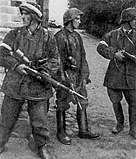
Back الحكومة البولندية في المنفى Arabic Gobiernu de Polonia nel exiliu AST Урад Польшчы ў выгнанні Byelorussian Правителство на Полша в изгнание Bulgarian Govern polonès a l'exili Catalan Polská exilová vláda Czech Polnische Exilregierung German Πολωνική εξόριστη κυβέρνηση Greek Pola ekzila registaro Esperanto Gobierno de Polonia en el exilio Spanish
Government of the Republic of Poland in exile Rząd Rzeczypospolitej Polskiej na uchodźstwie (Polish) | |||||||||||
|---|---|---|---|---|---|---|---|---|---|---|---|
| 1939–1990 | |||||||||||
| Anthem: Poland Is Not Yet Lost | |||||||||||
| Status | Government in exile | ||||||||||
| Capital | Warsaw | ||||||||||
| Capital-in-exile | |||||||||||
| Common languages | Polish | ||||||||||
| President | |||||||||||
• 1939–1947 (first) | Władysław Raczkiewicz | ||||||||||
• 1989–1990 (last) | Ryszard Kaczorowski | ||||||||||
| Prime Minister | |||||||||||
• 1939–1943 (first) | Władysław Sikorski | ||||||||||
• 1986–1990 (last) | Edward Szczepanik | ||||||||||
| Historical era | World War II and Cold War | ||||||||||
| 17 September 1939 | |||||||||||
• Presidency ceded by Ignacy Mościcki to Władysław Raczkiewicz | 30 September 1939 | ||||||||||
| 30 July 1941 | |||||||||||
| 5 July 1945 | |||||||||||
• Diplomatic recognition withdrawn by last country | 19 October 1972 | ||||||||||
| 22 December 1990 | |||||||||||
• Liquidation of apparatus accomplished | 31 December 1991 | ||||||||||
| |||||||||||
| Part of a series on the |
| Polish Underground State |
|---|
 |
The Polish government-in-exile, officially known as the Government of the Republic of Poland in exile (Polish: Rząd Rzeczypospolitej Polskiej na uchodźstwie), was the government in exile of Poland formed in the aftermath of the Invasion of Poland of September 1939, and the subsequent occupation of Poland by Germany, the Soviet Union, and the Slovak Republic, which brought to an end the Second Polish Republic.
Despite the occupation of Poland by hostile powers, the government-in-exile exerted considerable influence in Poland during World War II through the structures of the Polish Underground State and its military arm, the Armia Krajowa (Home Army) resistance. Abroad, under the authority of the government-in-exile, Polish military units that had escaped the occupation fought under their own commanders as part of Allied forces in Europe, Africa, and the Middle East.
After the war, as the Polish territory came under the control of the communist Polish People's Republic, the government-in-exile remained in existence albeit without effective power. It lost recognition of the majority of states upon formation of the Provisional Government of National Unity on 5 July 1945 though continued to be hosted and informally supported by the United Kingdom, while the last country to withdraw its diplomatic recognition on 19 October 1972 was the Holy See (the Vatican City). However, only after the end of communist rule in Poland did the government-in-exile formally pass its responsibilities and insignia onto the government of the Third Polish Republic at a special ceremony held on 22 December 1990 at the Royal Castle in Warsaw, while the liquidation of its apparatus was declared accomplished on 31 December 1991.
The government-in-exile was based in France during 1939 and 1940, first in Paris and then in Angers. From 1940, following the Fall of France, the government moved to London, and remained in the United Kingdom until its dissolution in 1990.

